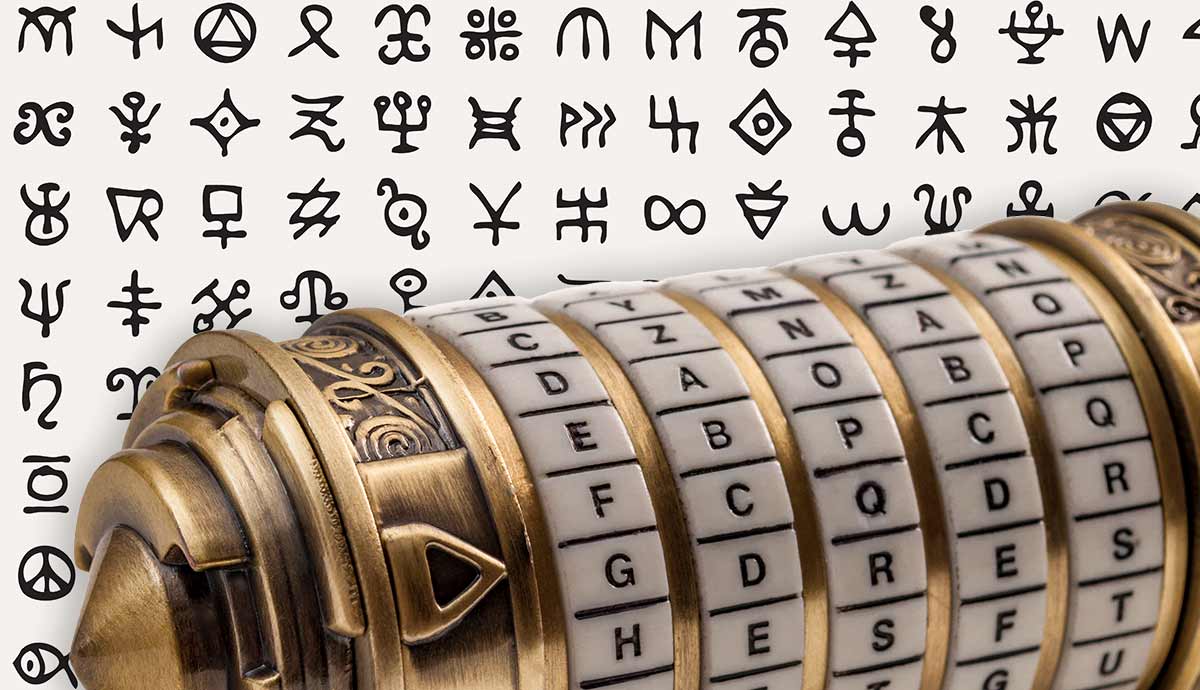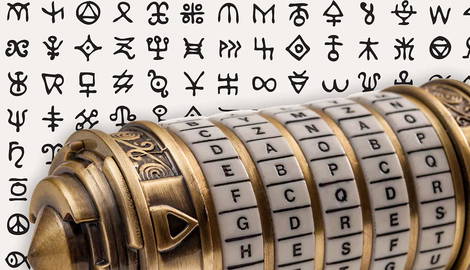
The need for secret communications arose very early in civilization. It progressed due to the “intellectual arms race” between codemakers and codebreakers, both being linguistic alchemists capable of extracting meaning from symbols. The term cryptography, which means secret writing, became popularly known in the 19th century through Edgar Allan Poe’s story, The Gold Bug. It comprises two components: encryption, the conversion of the original text into something nonsensical, and decryption, the reversal of the process to access the original text.
The Beginnings of Cryptography

The history of cryptography goes as far back as the Greeks, as chronicled by Herodotus in his The Histories. Steganography, or the complete concealment/camouflage of the message itself, was used. This could be done by complete memorization of the message, hiding it in a sheaf of musical notes, tattoos on the body, writing in invisible ink, etc. It was highly effective if it went undetected. However, the security was reduced to nothing if the existence of the message was obtained. This led to the emergence of cryptography, which acknowledges the existence of the message but encrypts it in such a way that it becomes useless without the secret key.
| T | I | A | E | C | E | ||||||||||||||||
| H | S | S | R | I | F | N | E | I | H | R | |||||||||||
| I | A | L | C | P |
The Rail Fence Cipher (original illustration), encoded as TIAECR HSSRIFNEIER IALCP, decoded by taking the first letter from each group, and then the next.
Transposition and substitution are the two indispensable parts of Cryptography. Transposition is a rearrangement of the text that occurs when changing the positions of selected segments of characters or letters, forming a sort of anagram. An example of transposition is the rail fence cipher, where a message is written vertically in equal sets in three lines but encrypted along horizontal lines. The same method is applied in the scytale, using a ribbon wrapped around a cylinder to decode it. Unraveling the anagram is only possible if the combination of arrangement is known.
Substitution is when the characters or letters themselves stand for something else. Cryptographers see the original text as being in plain alphabet form, which is switched following a certain positioning plan known exclusively by the sender and recipient, into cipher alphabet. For example, the cipher alphabet could correspond to the plain alphabet when it is shifted three places forward: that is, A becomes D, B becomes E, C becomes F, and so on. Hence, the word FALCON would be encoded as IDOFRQ. The combinations could include a certain repeated keyword; the discrepancy between the plaintext and cipher text could be of differing intervals, even backward, or excluding the position of vowels, etc.
Initial Substitution Ciphers & the Emergence of Cryptanalysis
| A | B | C | D | E | F | G | H | I | J | K | L | M |
| N | O | P | Q | R | S | T | U | V | W | X | Y | Z |
ROT13 Cipher, based on Caesar Cipher (original illustration)
The word PENCIL would be encoded as CRAPVY.
Initially, the Simple Monoalphabetic ciphers were the most popular, as they were quick and easier to use. A historical example is the Caesar shift cipher, used by Julius Caesar during the Gallic Wars to encode messages to his soldiers by switching Roman letters with Greek letters. ROT13 follows this principle, where alphabets mirror each other in groups of thirteen. The Hebrew Atbash cipher employs the same principle, where the first letter is coded as the last letter, and so on (i.e., A is Z, B is Y, C is X, etc.).

Nulls (or meaningless letters/words) are also inserted to throw off the decoders trying to pick up a pattern. Sometimes, a combination of numbers and letters is used, or numbers stand for alphabets to strengthen secrecy. The Pigpen Cipher, also known as the Rosicrucian, Napoleon, or Freemason’s cipher, was used in the 18th century to substitute letters with symbols using a common pigpen grid. A further type is the book cipher, where numbers separated by periods denote the volume, page number, line number, and then the specific word. All these are, however, easy to crack, whether by brute force or frequency analysis.

Cryptanalysis is the science of unscrambling the message without the knowledge of the key. It was first developed by Arab scholars, who were intellectually advanced compared to Europeans during 800–1200 CE. It was only from the 14th century onwards that cryptanalysis became widespread in Europe. The first proper European cryptanalyst was the Venetian expert Giovanni Soro, who became known as the father of modern cryptography. Philibert Babou was another prominent cryptanalyst to King Francis I of France. This led to the slow emergence and popularization of stronger, more complex methods of coding.
The Babington Plot and the Development of Stronger Ciphers

The Babington Plot of 1586 was an assassination plan to dethrone Queen Elizabeth I of England and replace her with Mary, Queen of Scots, due to religious reasons. It was thwarted as the coded letters of correspondence between Mary and Charles Babington, containing incriminating evidence, were decoded by double agents Phelippes and Gifford at the order of Sir Francis Walsingham. What is important is that despite the use of symbols and numbers in the place of plain alphabets, the code was easily cracked as it was monoalphabetic. It proved that for diplomatic communications, security was paramount, even at the cost of complexity. This gave rise to homophonic, polygraphic, and polyalphabetic ciphers, from an intermediate to extreme range of complexity, for various purposes.

Homophonic ciphers involve multiple cipher symbols for the plain alphabet based on their frequency of occurrence, sometimes even inventing symbols and mixing uppercase/lowercase or upside-down writing. The Great Cipher of Louis XIV, created by Antoine and Bonaventure Rossignol, was such a cipher. Comparatively, Polygraphic ciphers are more secure, as they code plaintext letters in large groups instead of exchanging positions individually. It is usually digraphic, involving paired letters, or trigraphic in rare cases. The earliest digraphic cipher is the Playfair cipher, created by Sir Charles Wheatstone in 1854. It is extremely complicated and uses mathematical principles, like the Hill Cipher invented by Lester S Hill in 1929. Polygraphic ciphers developed quite late, while polyalphabetic ciphers emerged in the 15th century.
Cipher Disks, Tabula Recta, and the Vigenère Cipher

The polymath Leon Battista Alberti created the cipher disk, an encrypting and decrypting device, in 1470. It consisted of two concentric circular plates engraved with Latin alphabets, mounted one on top of the other, one of which was fixed and the other movable. It could be used both monoalphabetically and polyalphabetically by following a schedule to change starting letter positions. For example, in the first instance, the letter A could stand for S; after 10 words, it could stand for M, hence changing the positions of all letters and defying frequency analysis decoding.
Johannes Trithemius invented the tabula recta in 1508, an important component in the future Vigenère cipher. The tabula recta is a square for all 26 alphabets written along both the x and y axis, where the letters are shifted by one place to their left in every succeeding row. It creates 26 different Caesar ciphers—with the y-axis being the plaintext and the corresponding x-axis letter as the cipher letter. For example, the word RABBIT would be encoded as RBDEMY, if shifted by 1 place for each letter. It is difficult for frequency analysts as the same letter is denoted differently each time.

This leads to Blaise de Vigenère’s famous polyalphabetic cipher, which was known as the le chiffrage indeciffrable as it evaded decryption until the Victorian era. It uses the tabula recta and involves keywords that are the same length as the message. For example, the message TAYLOR SWIFT (11 letters) will be encoded using the pre-established keyword CATS repeated as CATSCATSCAT (11 letters). Using the tabula recta, the cipher text can be created (RAFBMR ZEGFA) and decrypted to find the original message—where the keyword’s letter and the text’s letter’s confluence point is the cipher letter. Sometimes, even multiple keys may be used to complicate the encryption. Other polyalphabetic ciphers include variations of Vigenère’s cipher—the autokey cipher, the running key cipher, the Beaufort cipher, and the Gronsfeld cipher.
The One-time Pad Cipher and the Enigma Machine

Charles Babbage, the inventor of the modern computer, was a brilliant scientist and a skilled cryptanalyst. He was the first to break the Vigenère cipher, although Friedrich Kasiski was credited with this breakthrough after he published the book Secret Writing and the Art of Deciphering in 1863. Thereafter, the method came to be known as the Kasiski Test. The development of the radio and telegram necessitated the need for even stronger, almost invincible ciphers.

This led to the invention of the one-time pad cipher in 1918 by the American cryptographer Major Joseph Mauborgne. The keys for this cipher were devoid of structure—not recognizable words but random letters. It consisted of a pad of paper, each page bearing randomly sequenced letters as the keyword. This was then distributed to both the sender and the receiver. The basic principle of the Vigenère cipher remained the same. The complicated keys were for one-time use, for one message, after which it was destroyed. Thus, although ultra secure, it was rather wasteful and demanding—requiring a huge amount of keys, increasing the cost of manufacturing and distribution—and hence limited in use.

By the time of World War II, the paper-pencil approach was abandoned to a fearsome machine with the latest technology to perform scrambling. The Enigma machine was invented by Arthur Scherbius to secure diplomatic and military communications for the Germans in the wake of World War II. The Enigma device consisted of a keyboard to enter the plaintext message, a scrambler based on a rotor mechanism that scrambles the text, and a display board with light to indicate the corresponding ciphertext. The sender and receiver both needed to have one Enigma machine and the codebook containing the scrambler settings, which were changed every day. The encipherment and decipherment were mirror processes.
Decoding the Enigma, Building the Colossus, and Using the Navajo

Simon Singh writes in his The Code Book, “If necessity is the mother of invention, then perhaps adversity is the mother of cryptanalysis.” A French spy revealed the workings of the German Enigma machine and the codebook structure to the opposing Allied forces. This helped them create their Enigma machine and attempt to find the daily keys to decipher the messages. The Polish cryptanalyst group consisted of scientists, chess grandmasters, mathematicians, linguists, and crossword solvers to find the keys.
Later, these efforts shifted to Bletchley Park, and Alan Turing became an important figure in the decipherment of the Enigma through the use of Turing bombes. Although the German operators were supposed to choose three random letters, they often gave in to the pressure and chose three consecutive letters (known as cillies), making decipherment through the process of trial and error easy for the opponents. Extra scramblers and variable reflectors complicated the decipherment, so other methods, like hijacking codebooks from German ships.

The British also invented another code breaking device, the Colossus, the world’s first electronic programmable computer, to combat the stronger German Lorenz cipher. The Americans had the brilliant idea of using the nearly unknown tribal language of the Navajos. This acted like an unbreakable code, as the language had no link with Asian or European languages. It eliminated the need for codebooks, which could become a liability and was facilitated by the fact that the Navajos were accustomed to memorizing their folk tales and family histories.
Modern Mechanized Cryptography Using Public Keys

In the present Information Age, where the most valuable currency is information, the need for encryption has become all-encompassing—no longer a requirement of diplomatic channels only but a domestic, economic necessity. Using and keeping symmetric keys private meant the tedious use and distribution of one-time pads for key exchange or other complicated methods. It was not a feasible idea, both in terms of speed and efficacy; hence, mathematicians and computer scientists came up with the idea of secure public keys. In a public key cryptosystem, the encryption key is made public and separated from the decryption key.
The Diffie-Hellman-Merkle (Asymmetric) Key Exchange (1976) was one of the first public key encryption systems. It’s called asymmetric because the encryption and decryption keys are different. It enabled secure and secret communication while using the global internet, which was an insecure channel prone to eavesdropping. There are two explanations of the mechanism:
Process I: Person A sends her secret locked with Lock A, in a virtual box to Person B. Person B locks the already locked box with Lock B and returns it back to Person A. Person A then removes her lock on it and sends it back to Person B, who now only has her own lock to remove to access the secret message.
Process II: Persons C and D choose two secret colors individually (BLUE and YELLOW, respectively). They mix these secret colors with the publicly chosen color (RED). The result is PURPLE for C and ORANGE for D. They then send the mixed colors to each other using a public channel. Upon receiving each other’s colors, they add their secret color to the mixture—the result should be the same color for both (BROWN).

The problem posed here is that the secret color can be deduced if one knows two parameters. However, in the example, as the colors were stand-ins for huge numbers, it is difficult and nearly impossible for even supercomputers to deduce the secret keys. Decoding is extremely expensive and takes far too much time to be of any practical use. The RSA builds upon the same principle, except it uses two large prime numbers as the secret ingredient, and the semiprime number created from these is the public key. Messages can be encrypted by anyone but only decrypted by those who have the prime number keys. The security depends on the difficulty of factoring the product of the two large prime numbers. The email is an example of this—the mail address is publicly known, but the passwords are the private keys to access the messages.
Cryptography in Popular Culture and the Future

In the latter half of the 19th century, public interest in cryptography rose to a frenzy, leading to the publishing of ciphertext in the “agony columns” of newspapers for cryptanalysts and amateurs to solve. The encrypted messages were not just challenges but sometimes criticisms of public figures and organizations. Ciphers found expression in literature, for example, in Jules Verne’s Journey to the Centre of the Earth, where runic characters had to be turned into Latin alphabets and then reversed using a mirror to get the clue. Another fine writer of cryptographic fiction was Arthur Conan Doyle, notably in his Sherlock Holmes story, The Adventure of the Dancing Men, where stick figures stand for Latin alphabets, which Holmes decodes via frequency analysis.
The future holds the choice of either making cryptography free and easily available to everyone or imposing heavy restrictions on it as the domain of diplomatic channels alone. Cryptographic freedom could mean its misuse by criminals and terrorists, while a lack of security would mean that anybody’s sensitive information could be accessed. The world, therefore, remains divided on this. Although modern cryptography is nearly invincible, there remains the scope and necessity for furthering the research of encryption due to the increasing cyber-attacks.









